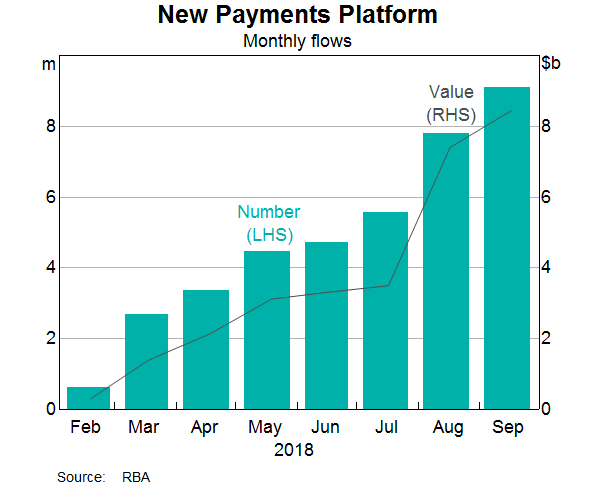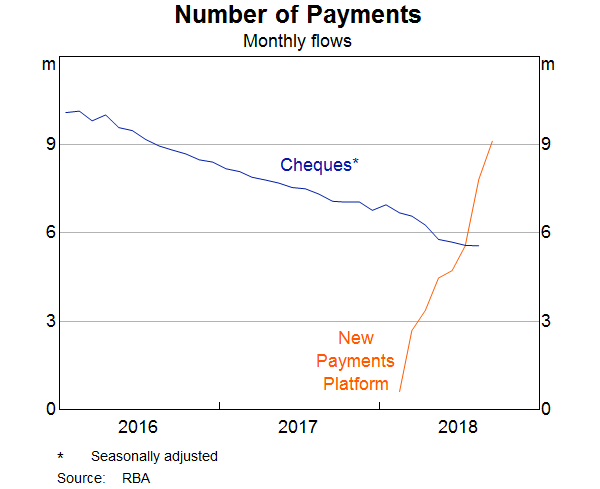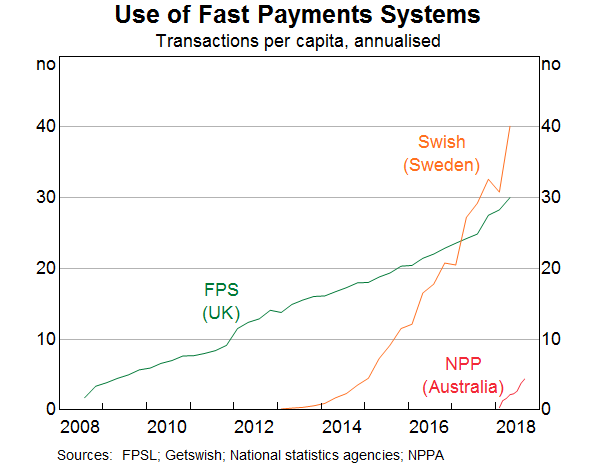Speech An Update on Australia's New Payments Platform

Tony Richards
Head of Payments Policy Department
Chicago Payments Symposium, Federal Reserve Bank of Chicago
Chicago –
- Audio 13.35MB
- Q&A Transcript
- Download 424KB
It is good to be back at the Chicago Fed's annual Symposium. Four years ago I attended the Symposium and spoke in a session on ‘Payments Roadmaps: Lessons from International Markets’. At that point, the Australian payments industry had embarked on a journey to bring about a major upgrade in our payments infrastructure. We were close to, but hadn't yet secured, agreement to fund the build of the New Payments Platform (or NPP), which was to be a new set of payment rails to allow real-time payments. Funding for the NPP was indeed secured soon afterwards, and the hard work began. The public launch of the NPP occurred in February this year.
Four years later, this opening session is entitled ‘Lessons on Payment Improvement around the Globe’. So today I will give an update on our project over the past four years, and will provide some early lessons learned. I will try to limit the Australia-specific institutional details and to focus on the more general issues that will be of interest to this audience.[1]
The History of the NPP
The Reserve Bank of Australia is the principal regulator of the Australian payments system. The Payments System Board is the Bank's decision-making body and has a mandate and regulatory powers to promote competition and efficiency and to control risk.
Over 2010-2012, the Reserve Bank consulted with the payments industry and looked at international developments to produce a report which was called the Strategic Review of Innovation in the Payments System.[2] In the conclusions to the Review, the Bank identified a number of gaps in the payments system that it anticipated would become increasingly problematic in the years to come. The Bank concluded that it should be more proactive in setting strategic objectives for the payments system. The set of strategic objectives set by the Bank reflected the gaps identified in the Review. One of these was relatively straightforward to solve. This was that the industry should move quickly to same-day settlement of all five of the daily batch exchanges in Australia's Direct Entry system – this system is in many ways similar to your Automated Clearing House system.
The four other strategic objectives were likely to require the industry to build a new payment system and were expected to take four or five years to implement. These were to provide end-users of the payments system with:
- the ability to make real-time retail (or low-value) payments – that is, payments where the recipient has visibility and use of the funds in seconds rather than hours or days.
- the ability to make and receive retail payments outside of normal banking hours – indeed on a 24/7 basis.
- the ability to send more complete remittance information with payments than is available in the 18 characters that can be transmitted with a Direct Entry payment. We noted the desirability of moving to ISO 20022, a flexible, modern and international messaging standard.
- the ability to address payments in a relatively simple way, such as to an email address or a phone number. This is in contrast to the existing Bank-State-Branch (BSB) and account numbers of the Direct Entry system, which requires the sender to correctly enter up to 15 digits.
The Australian Payments Network, the industry association which includes both large and small payments institutions, coordinated the industry's response to the Strategic Review.[3] An industry committee came up with a detailed proposal for new infrastructure that would meet the strategic objectives, and this proposal was welcomed by the Reserve Bank in February 2013, eight months after the release of the conclusions paper from the Strategic Review.
Over the next year and a half, the industry contracted with KPMG to help manage the project and worked on project planning, the development of business requirements and the tenders for service providers. Financial institutions were then invited to subscribe as shareholders of NPP Australia Limited (NPPA), a new company established to operate the NPP as a mutually-owned utility infrastructure. In late 2014, 13 institutions (including the Reserve Bank) agreed to become shareholders in NPPA, which then signed a contract with SWIFT to build the NPP.
Importantly, three of the 13 initial participants and NPPA shareholders are aggregators, or service providers to smaller financial institutions. As the build of the NPP progressed, these three participants were working both on their own connections to the NPP and on building indirect NPP connectivity solutions. As a result, when the NPP went live there were around 40 smaller banks, credit unions and building societies that were also able to offer NPP services to their customers.
What is the NPP?
The NPP consists of two sets of new payments infrastructure – the NPP ‘Basic Infrastructure’ and the Reserve Bank's Fast Settlement Service (Figure 1).

The NPP Basic Infrastructure is operated by SWIFT under a contract with NPPA. It includes a new domestic SWIFT network connecting participants to each other and to the FSS. This is via payment gateways at each participant and the Fast Settlement Service that route ISO 20022-format messages, with up to 280 characters of data, across the network. That is, the NPP is not hub-based, but is a distributed network. Importantly, the Basic Infrastructure also includes the Addressing Service, where participants can register a customer's transaction account to an identifier or ‘alias’ called a PayID, which may be a phone number or email address (or Australian Business Number).
The Fast Settlement Service (FSS) is a separate service of RITS, which is the Reserve Bank's real-time gross settlement (RTGS) system. It allows the real-time settlement of each NPP payment in the Exchange Settlement accounts – the equivalent of Federal Funds accounts – of the relevant NPP participants. That is, there is no netting or batching – payments are settled line-by-line in real time. This means that participants can make funds available to the recipient customer immediately, without settlement or credit risk.
‘Overlay services’ represent another element of the NPP ecosystem. Whereas the Basic Infrastructure can be thought of as a set of rails, overlay services can be thought of as the trains that will use the NPP rails and will allow all sorts of payment services to be offered to end-users. These will be commercial payment services that leverage the Basic Infrastructure and the ability to make real-time, data-rich and easily addressed payments. They may be simple rule-books that set standards for participants or they may be more complex payment solutions that involve new message types and interactions with external entities or databases.
The first overlay service, Osko by BPAY, is a basic fast payment with enhanced data. However, BPAY has plans for additional overlays including request-to-pay and payment-with-document services. NPP Australia is also working actively with other potential overlay providers. Possible use-cases for additional overlay services include e-invoicing, superannuation payments, and payment services supporting the capital markets (which have long used ISO 20022 data in their operations).
Initial NPP operations
After industry testing through much of 2017, the NPP became operational for industry ‘live proving’ in November 2017. It was launched for public use on 13 February this year. This involved around 50 institutions initially, with this number now having increased to around 65 institutions.
As with any completely new payment system, financial institutions have mostly taken a staged approach in their rollout strategies, gradually introducing services, channels and customer segments. In some cases this was to manage risk and allow them to fine-tune their systems and processes, while in other cases it has reflected different stages of readiness. The major banks have mainly focused initially on providing payment capabilities to consumers ahead of businesses, with the rollout to consumers now at a fairly advanced stage.
At this point, there are more than 50 million Australian bank accounts accessible via the NPP, with that number growing steadily. The number of PayID registrations has just reached 2 million – Australia has a population of 25 million. And monthly volumes and values of NPP transactions have been growing strongly (Graph 1).

One interesting statistic is that the number of payments occurring through the NPP has already surpassed the number of cheques that are being written by Australian households, businesses and government entities (Graph 2). An international comparison also offers another interesting metric. While each country is its own special case, it appears that the adoption of the NPP is proceeding at least as quickly as occurred for some other fast-payment systems (Graph 3).


As long as the rollout of NPP to households has not been completed, advertising of Osko by BPAY has been limited, but I would expect that this will be picking up, and that financial institutions will also be doing more promotion of real-time payments to their customers. So I would expect the value and volume of NPP transactions to continue to grow strongly.
Some early lessons learned
While the NPP was launched less than eight months ago, I think one can make a number of observations that may be of interest to this audience regarding its design and build, as well as its operation to date.
- The presence of a well-resourced project office (from KPMG as well as from APCA and then NPPA) that was independent of the participants was important in the design, build and test phases. This ensured high quality papers for meetings, brought skills that might not have been readily available from participants, and provided independent perspectives during debates about the design and build.
- Having three aggregators (or service providers) involved as participants was important in ensuring the broad reach (and public legitimacy) of the NPP. The majority of the institutions that were ready to go on Day 1 were small banks, credit unions and building societies using the services of aggregators.
- While the build of the Basic Infrastructure and FSS in the centre were major projects, the internal builds for NPP participants were the most challenging tasks. The systems of large banks are inevitably extremely complex, and upgrading them to allow real-time posting and 24/7 operation has taken longer than expected for some. Banks have also placed significant focus on ensuring that their fraud detection systems can support real-time payments.
- Ubiquity (or near-ubiquity) is important. It is hard for a new payment system or for individual participants to go out and market aggressively to customers until a critical mass of institutions and accounts are on board. However, balancing this point and the previous one is a challenge. Decisions to launch to the public can only occur once a critical mass of participants is ready, but a program cannot be expected to move at the pace of the slowest participant.
- Real-time settlement is going well. The challenges raised by out-of-hours and weekend operations can be met by appropriate central bank liquidity arrangements. Banks can easily move the balances in their Exchange Settlement accounts between the FSS and the RBA's main RTGS system during normal business hours. These balances are then all moved into the FSS overnight and on weekends. In addition the Reserve Bank introduced a new liquidity facility for open-dated repos, which are available to holders of Exchange Settlement accounts at no penalty relative to the Bank's policy rate.
- Five or six years ago, some banks may have questioned the case for moving to real-time payments, however no one is questioning that case now. Indeed, the early signs are that banks are looking to move their Direct Entry payments over to the fast rails sooner than was earlier expected. Similarly, the decision to move to the ISO 20022 message format and richer data will be an important one for future innovation.
- It was important to have the Addressing Service ready to launch on Day 1. PayIDs get around the problems of end-users having to enter lots of numbers, give certainty about the recipient, help avoid ‘fat finger’ problems and mistaken payments, and can reduce fraud.
- The involvement of the central bank – from the policy side, as well as in the delivery of settlement arrangements and as a banking service provider – has been important. I suspect that some industry participants may initially have had some concerns about having the Reserve Bank involved, but that they would recognise now that our involvement helped to get some key aspects of the design, build, and business rules right.
- The fact that the Basic Infrastructure will be operated as an industry utility available to all, with commercial payment services to be provided by separate overlay services, was also helpful in getting agreement among participants in the design phase.
- With the initial build mostly complete, the industry has ambitious plans for additional NPP functionality. While some of this could potentially be delivered via overlay services, it is likely that there will be additional central functionality provided or arranged by NPPA – for example, possibly a central consent and mandate service that could be used to enable direct debits though the NPP. As NPPA increases its capabilities, it may also look to new means of providing functionality. On Friday it announced an API framework with three sample APIs.
Conclusion
There is, of course, significant change underway in payments, in both technology and business models. So there will be no shortage of work for our payments industry as it completes the initial build of the NPP and then looks to continue to meet the changing needs of its customers. But overall, the Reserve Bank – and I think the broader Australian payments industry and the wider community – is very positive about our experience over the past six years as real-time payments have moved from an idea to a reality and we have seen a major advance in our payments infrastructure. As we have undertaken this journey we have benefited from the experience of other countries and I am looking forward to hearing some additional international perspectives in this Symposium.
Endnotes
For further information, see Alexandra Rush and Riaan Louw, ‘The New Payments Platform and Fast Settlement Service’, Reserve Bank of Australia Bulletin, September 2018 and Michele Bullock, ‘Fast Payments in Australia’, Address to Seamless Payments 2018 Conference. [1]
Available at https://www.rba.gov.au/payments-and-infrastructure/payments-system-regulation/past-regulatory-reviews/strategic-review-of-innovation-in-the-payments-system/conclusions/. [2]
The Australian Payments Network (or AusPayNet) was formerly known as the Australian Payments Clearing Association (or APCA). [3]